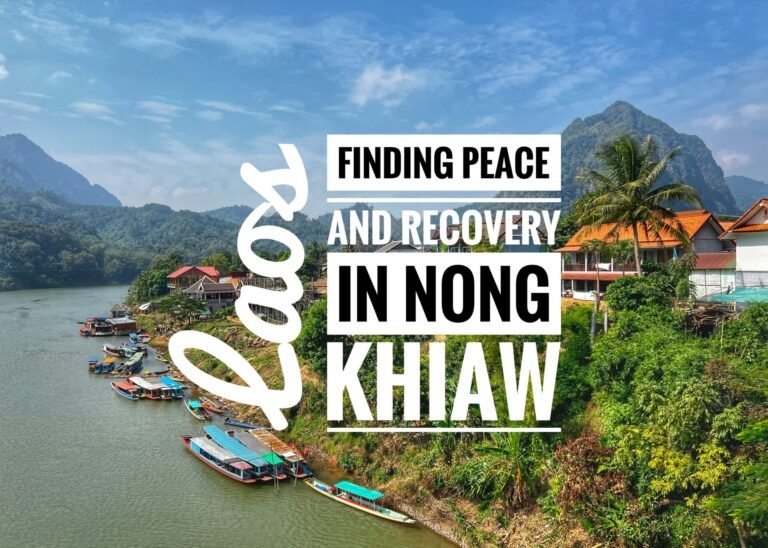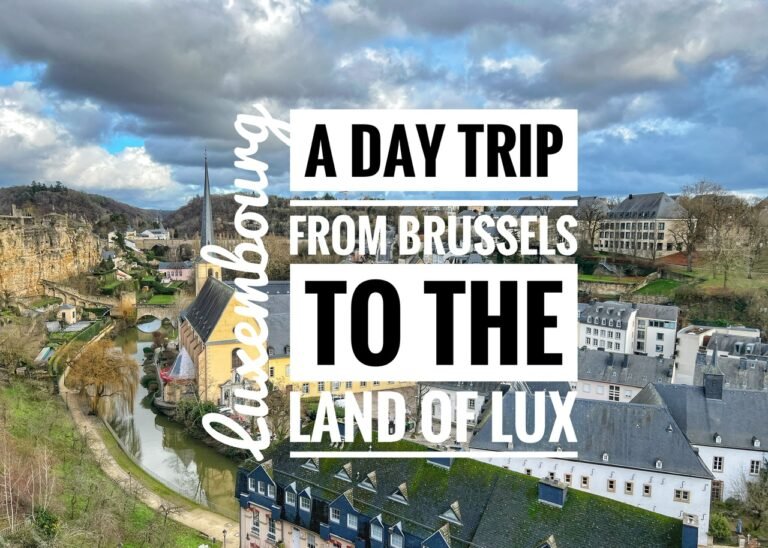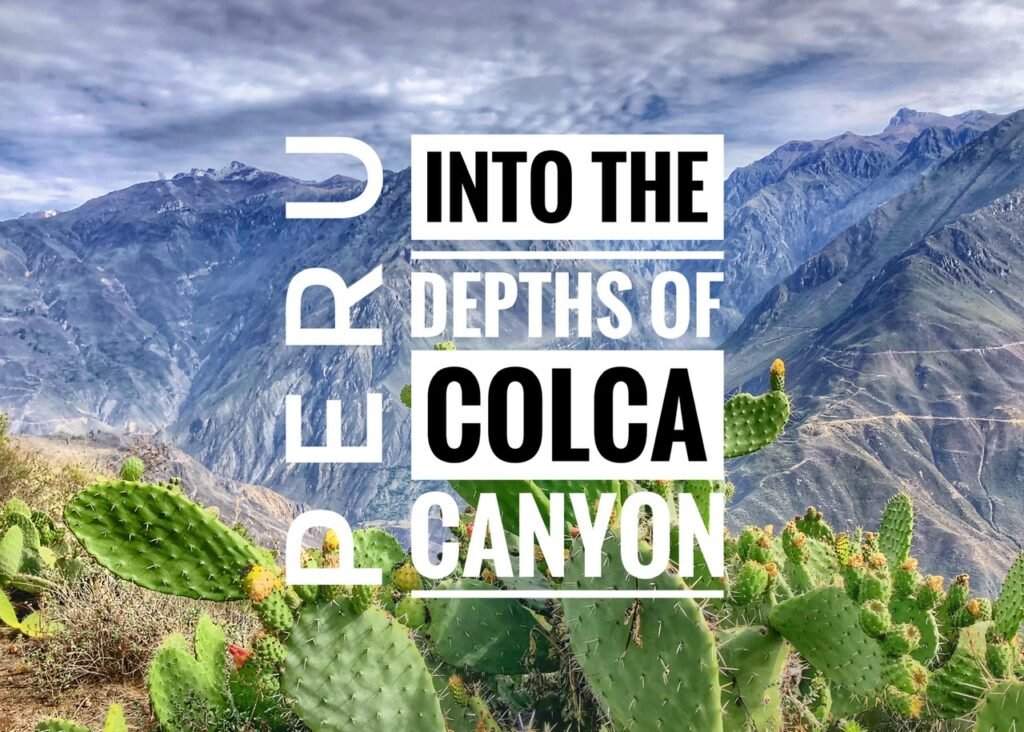
The Grand Canyon is far from being the deepest canyon in the world. In fact, the beast we trucked 37 km (23 miles) all the way down, around, and back up, is double the depth and the world’s second deepest canyon at up to 4160 meters (13,640 feet.) (The first deepest is also in Peru not far from here and quite inaccessible.) For three days, we spent our time traversing the simply stunning canyon, soaking in hot springs, eating way too many carbs, and making new trail friends, both the Euro and furry variety. It was an ultimate Peruvian trekking experience and despite the weather of the “rainy season,” we’re so glad we got the opportunity to hit the trail again. It’s been too long since we’ve done any real overnight hiking and it felt spectacular. Plus, of course, it was good training for what’s to come…
From Cabanaconde (3287 meters/10,827 feet), which is deemed by Lonely Planet as “the edge of the true canyon experience,” we decided on the 3 day/2 night option. We wanted to dip our toes in as much of this divine canyon as possible. The first night we spent on the far west side of the canyon at Llahuar, which is known for having the most striking views and hot springs. And for the second night, we spent in the heavily touristed “oasis” at Sangalle. Fortunately, low season and the pandemic seemed to keep crowds at a minimum.
Getting There
From Arequipa, we went to Cabanaconde by taking a local bus to Chivay on Camino del Inca which is found just behind the bus station on “Javier Perez de Cuellar” street number 107. Buses leave everyday from 5 am to 1 pm every hour and cost 20 sols or about $5. Along the way, we got to go over a pass which was the highest we’d ever been (in elevation…haha) at 15,912 feet or 4850 meters.



From Chivay, you can take a combi (small van) to Cabanaconde, which run regularly, but the last one leaves between 2-3 p.m.
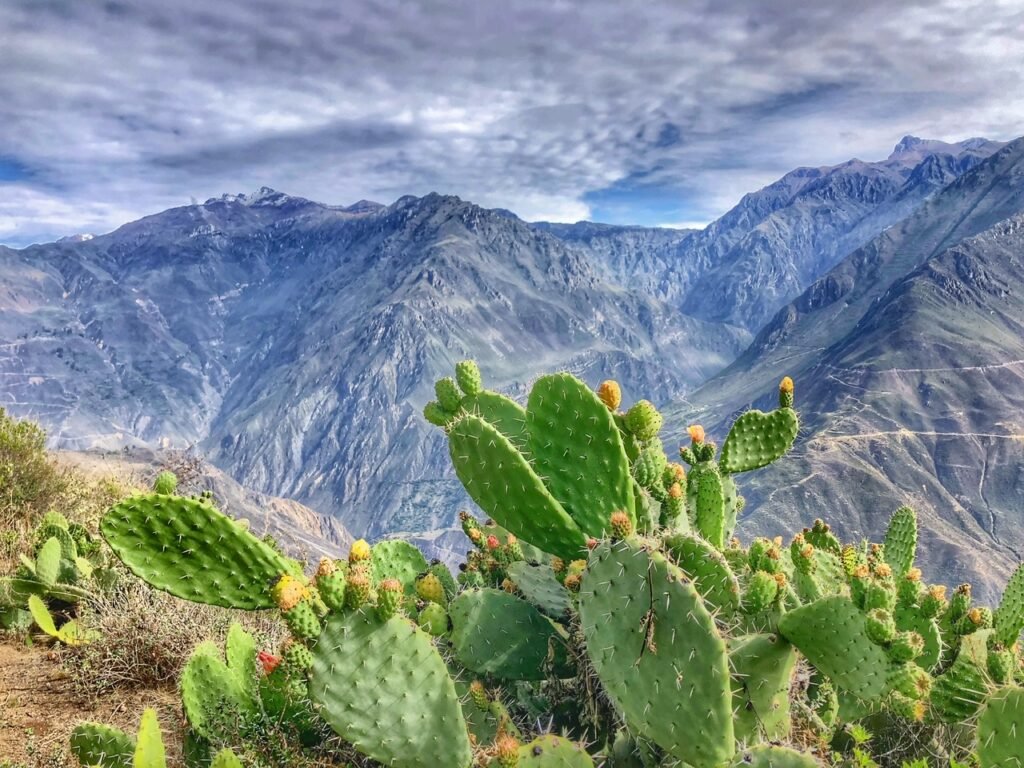
Day 1: (16.3 km)
We were graciously greeted with alluring high clouds and sunshine on the first morning as we hit the trail at 8:00 along with two other couples from our hostel, one Swiss and one Dutch.

A quintessential stone church on the way out of the village of Cabanaconde.

A worker toils in a sea of corn.

Another hard worker. Señor Burro has a difficult life. People can hire him to go up and down the canyon carrying their things, or their bodies, for 60 sols. ($12.50/day). Sad.

Greg leads our pack of six, guiding the way with our always trusty Mapy.cz app. It never failed us along the whole route. This is also around where we were supposed to pay 70 sols ($18) each for our tourist tickets, but no one was ever around to demand payment. Can’t say that we minded…

Colca Canyon slices like a laceration through the high Andes for more than 100km (60 miles.) It was really difficult to ever get a picture of the depth, but the line you see is one of the many trails that zig zag throughout the canyon.

It was so amazing to be utterly immersed by nature again.

When we said pack of six, we meant seven. This Labrador-looking pup, one of MANY who kept us up all night the night before, became our constant companion on the route and over time, we reluctantly grew to love, and even bestow him with a name. However, that wasn’t until day two, when he caught up to us nearly two miles away from the accommodation we had left. From that point forward, Sunny was “ours.”

Our other new trail friends…a Dutch couple named Rick & Rosa, and a Swiss-French couple named Bryan and Magali. We were lucky enough to traverse the entire trail with Bryan and Magali and had a wonderful time learning about Swiss politics, fondue and trying to extract the French language out of the 20-year depths of Mandy’s brain.

Since Mandy took all the photos, here’s one of her. And yes, you’ll notice us wise 40-somethings now have trekking poles, which we bought for $7 each in Cusco. No going back on this matter.


After five hours of steady and precipitous downhill action, we finally arrived at the base of the canyon, where the Rio Colca slides through with tremendous fervor.

What’s more fun than going down? Going up! This road walk only took about 45 minutes longer from the river, but at 12:30 pm, this is also when we were smacked with our first drops of rain. Fortunately, it was never enough for the plastic suffocating devices (ponchos) to have to be deployed.


Other than the lodge, there was not much to the village of Llahuar. Just a few ramshackle concrete houses and a fuzzy baby donkey.

Arriving to our first hostel for the night at Llahuar Lodge & Hot Springs for 80 sols or $20/night.

At the lodge, we were welcomed by a handful of very friendly staff members, who immediately served us an Ariquipena beer and some egg sandwiches. Unfortunately, we would have to wait 6.5 hours for a substantial meal, which ended up being delicious, but a bit pricy at 28 sols each ($7).

Another little friend we picked up belonged the family who owned the lodge. Greg teaches him how to be a tough man. Unfortunately, shortly after, the same little boy decided to pee all over the chair, so not sure if he learned the lesson.

The little boy also decided to accessorize Sunny, who passed out immediately at our feet.

After lunch, we checked out our digs, which were very basic accommodations, but thankfully with very warm blankets, comfortable beds and pillows. We were psyched to see hot water tanks on the roof of the rustic bathrooms, but unfortunately those only seemed to be there for decoration.

After a siesta, the other option would have to do. So we headed down to the hot springs pools with Magali and Bryan where we sat like ducks until we were puckered and pruny. Unfortunately the water wasn’t very hot, but it seemed far warmer than the air temperature and the rain that started to pitter on us. This eventually turned into a deluge around 4 pm. Rainy season also kept us from being able to enjoy the other hot springs which are actually at river’s edge because the high waters simply tumbled over.

Hydration is key after a long day of hiking, which Mandy takes seriously! Haha.

She also practices for the mucho frio climates to come.

We awoke at 6 and heading to our complimentary breakfast, which was pancakes, (sin syrup), tea and coffee. Of course, one of those tea options in Peru is always coca leaves. Fortunately we were on the floor of an enormous hole in the earth, so the elevation wasn’t really an issue here.

Day 2 (13.7 km)
Day 2 began with mostly sunny skies and consisted of going up the opposite side of the canyon, and back down again…because….why not? Haha.

Up on the ridge, we arrived to another village called Belen. All the houses were stone with tin roofs, and the village, of course, had an obligatory soccer field though we’re not sure who would fetch the ball if it got kicked into the canyon…

Looking down the canyon toward the previous night’s accommodation. Wow, we had already come so far! This was around the time where Sunny caught up to us. It was also shortly after we had to take a slight detour thanks to a rockslide that had tumbled toward the village of Sangalle (our destination for the night) Eek.

Bryan and Sunny on the trail to the right of a Puya, also called the “Queen of the Andes.” It’s related to the pineapple and resembles a giant agave and grows to the height of up to 30 feet. It’s the world’s largest bromeliad and one of the tallest plants in the world. It blooms once every 80 years, living up to 150 years.
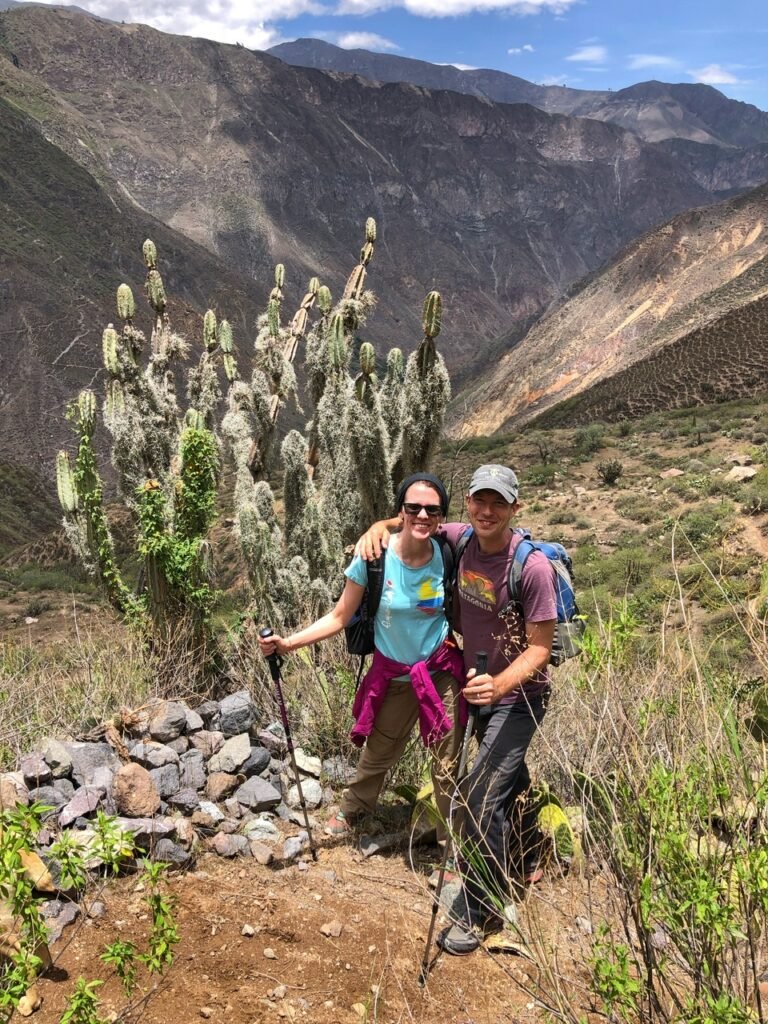
100% in our happy place. On the trail, in the sunshine, and with friends to take our picture. What a rarity.

Walking through a massive field of fruiting cacti.

Meeting Panchito, a tried and true villager, who promised the best prices and discounts at his “supermercado.”

Spying our home for night two…the entrancing oasis of Sangalle.

It was complete with fairytale waterfalls and babbling brooks.

We stayed at the appropriately named Oasis Paraiso, which had individual cabanas, private bathrooms, hot water, lush greenery, and a swimming pool with a waterfall. (71 soles or $19). Most people who hike the canyon come down from Cabanaconde and stay one night in this oasis. It’s easy to see why it’s so popular.

One of our dinners at Oasis Paraiso, which was a tremendous portion including soup and tea for 20 sols ($5), a better value than the previous night. They also offered vegetarian options. Not the most amazing food, but certainly quality fuel after a day of trekking.

Oh, and guess who also capitalized from those portions? Sunny also rotated between both of our rooms all night whimpering outside our doors.
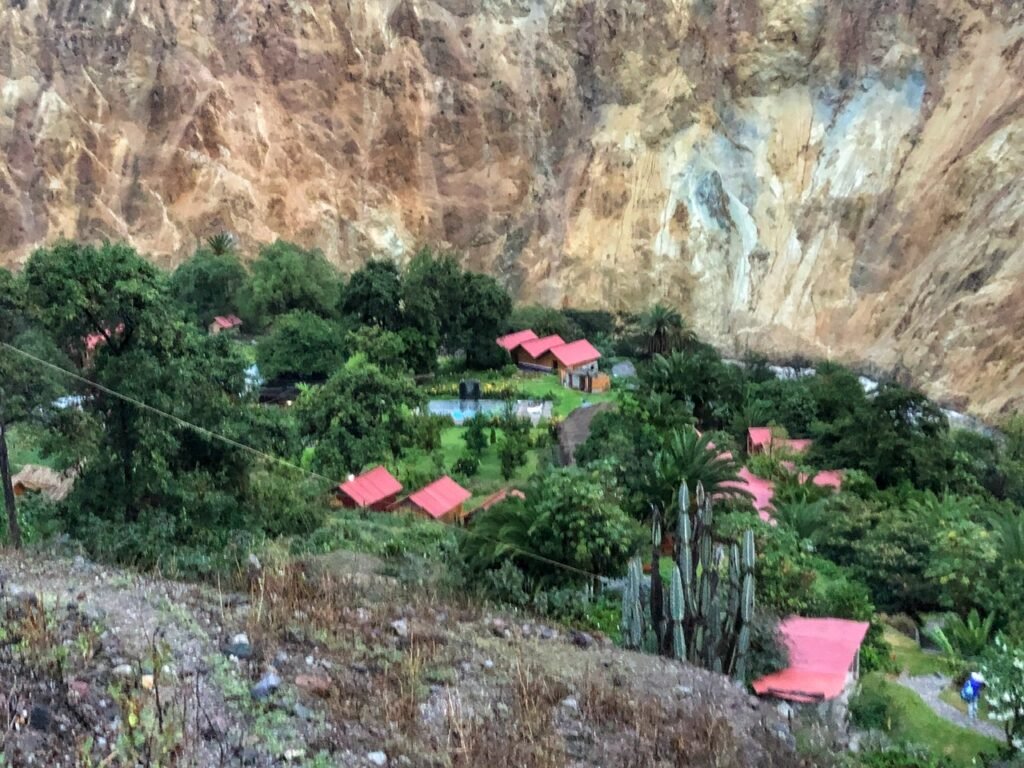
Day 3 (5 km)
The next morning, we woke up at 4:30 so we could hit the trail by 5:30 when the stars go to sleep. This is absolutely necessary because the climb out of the canyon is kind of a doozy, considering it’s 1094 meters or 3589 vertical feet. Not something you want to do with the sun beating on you… According to the guidebook, it should take 1.5 hours for a “super fit person,” 2-2.5 hours for a “fit” person, and 3-4 hours for an “average” person. We were pleased to perform a solid B-grade at 2.5 hours, including an abundant amount of breaks. The view of the oasis as we departed is pictured above.


Up, up, up….The girls, still smiling, pause on the trail.

The sun edged its way towards us as we caught glimpses of the TRUE summit. (There were a couple fake outs).

Reaching the mirador! We did it!!

Bryan and Greg celebrating the finish line.
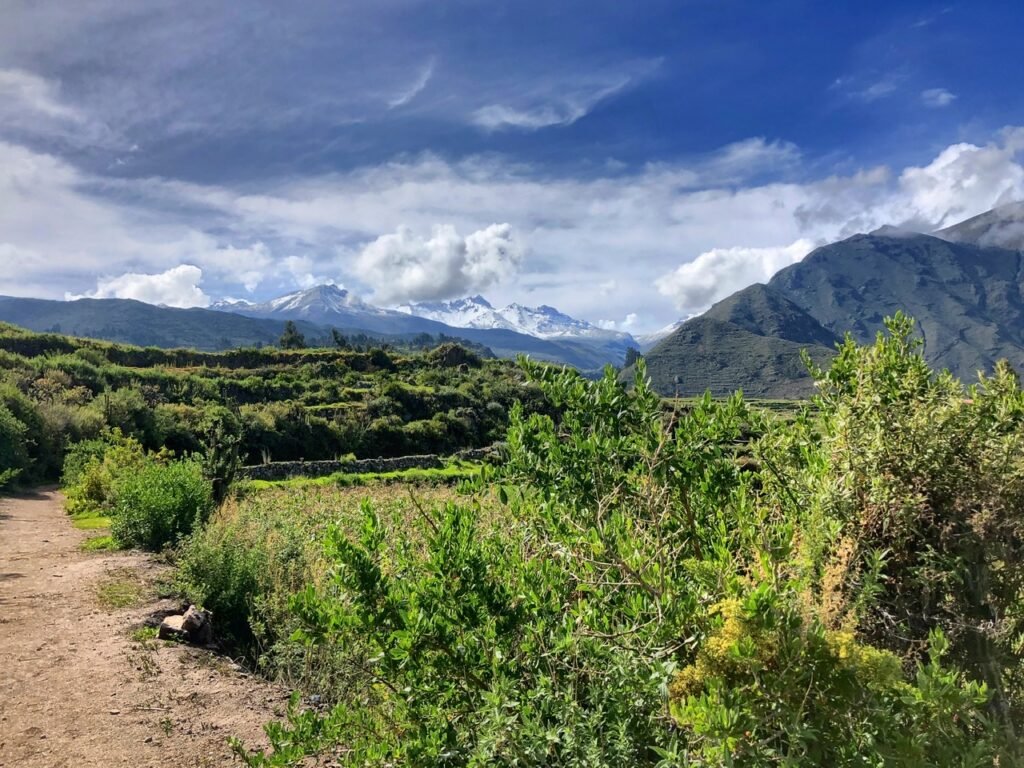
Back to the land of snow-capped mountains. Peru is beyond beautiful!

We were all ready to take naps upon our arrival back to Cabanaconde.
Cabanaconde

Only 20% of tourists make it to ramshackled Cabanaconde. According to our guidebook, it’s the gateway to the “true canyon experience,” far away from tour buses and selfie sticks. This authentic village of 2400 is where you gain access to the deepest points of the canyon and all the long distance trails. All were reasons exactly why we liked it. The town plaza of Cabanaconde. Combis (small vans) leave and arrive from here back to the canyon hub town of Chivay, about 1.5 hours away.


Our room at Hostel Pachamama ($21/night). We definitely recommend it mostly because of Ludwig, the owner who is incredibly helpful at planning trekking routes and other travel arrangements. He also held our bags while we were on our trek. It was comfortable and warm, and had super hot showers with good pressure. Internet was sparse as with most places in this area. It had four floors and about nine rooms. They’re currently renovating their restaurant.

Breakfast was large and complimentary, including an omelet, pancake, two rolls, cheese and coffee/tea.

Another view of the streets of Cabanaconde.

Everyday from about 4-8 pm it poured. We caught this sweet lady shortly before the deluge began on day one.

There were not a lot of food options in Cabanaconde so we settled for one that was open. Our meal included a delicious bowl of Peruvian potato soup. This was fine. The rest of it…terrible.

And we finally broke down and tried the very popular, radiator-fluid-resembling Inca Cola. It didn’t taste like radiator fluid though. It was worse….more like bubble gum flavored snow cone syrup. Glad we got that over with.

A local produce market

Enjoying the terrace at Hostel Pachamama. Loved how they had repurposed old hiking shoes as planters.

These junky little Daewoos from Korea are called Tikas in the Arequipa region of Peru and are absolutely everywhere. According to a local, years ago, a corrupt Peruvian government official made a deal with the manufacturer in Korea to import tens of thousands of these vehicles and flood the local market. They’re incredibly unsafe tin can death traps on wheels that break down regularly much to the frustration of the locals. In short, avoid these taxis ?

Us with Bryan, our new Swiss trekking friend, after our last breakfast in front of Hostel Pachamama.
Yanque

We also stayed a night in Yanque which had a lovely main square with a beautiful baroque church, pre-Incan ruins, and arresting views of the surrounding snow capped peaks. Boarding a local mini van called a combi to head there. We were squished in the back with all our bags.

As we headed up the canyon, it slowly faded away and turned into a lush green valley flooded with ancient terraced fields.

Not usually a black and white photo editor, but for this it just felt right. A mother and son riding the local combi (mini bus) from Cabanaconde to another local village. Even though there are plenty of tourist and taxi options in Peru, and we were crammed in the back with our bags and another person, this slice of authenticity is why we choose to do it this way. And we wouldn’t trade it, no matter what our budget.

Our hotel, La Foyer Colca in Yanque was bright and cheerful. However, the internet was out and after 4 days of weak or no signal, we were dying ? ($22/night.)

The beautiful view from our window. Incredibly tranquil.
Greg soaking in the mountains and the sun.

The town square

Calda Blanco Soup. It was delicious…until Mandy found some surprise chicken feet submerged inside.

Fried trout with rice and potatoes. ($3.75) Not the best we’ve had.

We thought this cutie patootie was fake at first. Only in Peru do you walk through town and find a baby alpaca tied on a super short leash outside of someone’s house. ?

Street scene Yanque.

The church in Yanque is baroque which is almost churrigueresque, an elaborately decorated Spanish style. It was damaged in a recent earthquake and inaccessible.
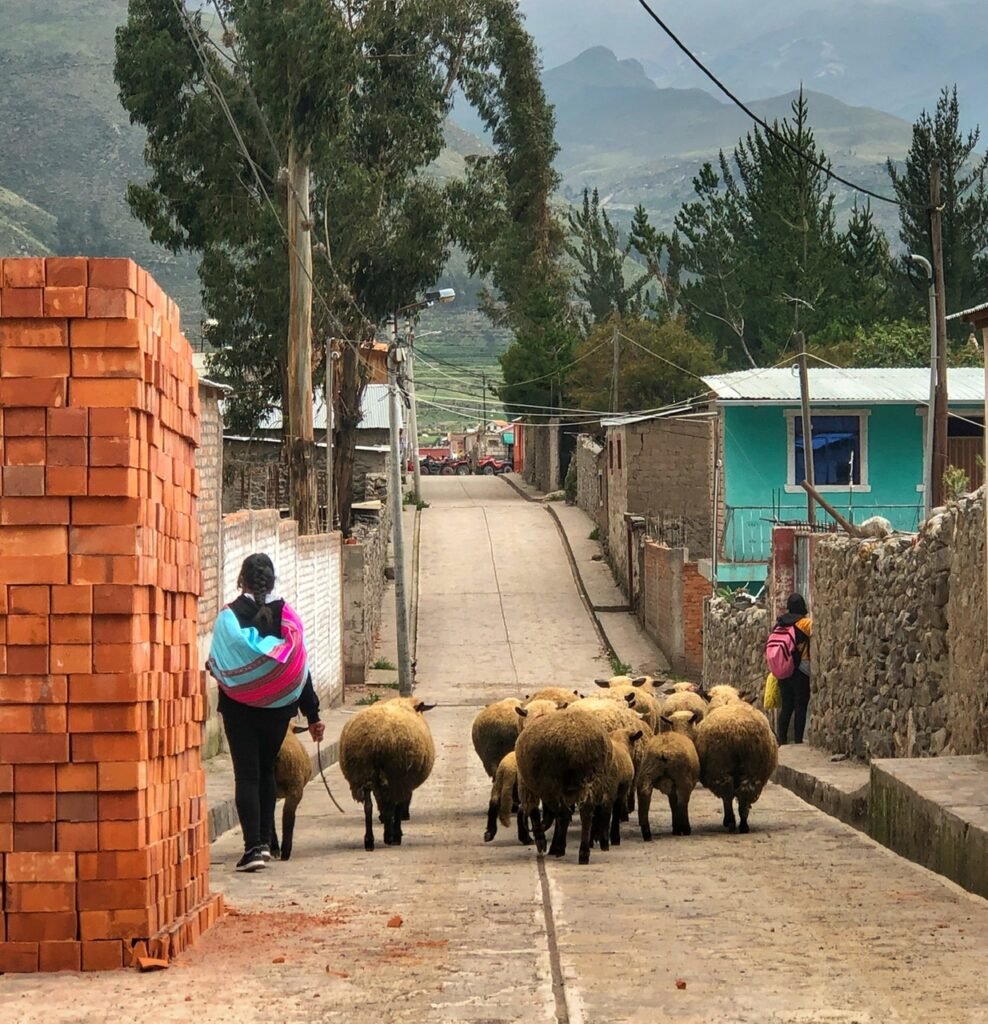
Heading home from a day’s work.


Every morning a group of local girls dance in traditional costume in Yanque’s square for the tourists coming through to visit the Cruz del Condor. By the way, we didn’t see the giant Colca condors because they migrate during January and February and it’s a lot of money to go visit when the mirador when it’s not even guaranteed.

A vendor in the plaza. Greg decided to buy some cozy woolen sleep socks because we’re gonna need them in the next few weeks!

From Yanque, we walked 50 minutes to the ruins of Uyo Uyo, which included absolutely picturesque scenery along the way.



The ruins are the remnants of a Pre-Incan Settlement and we had the insanely tranquil place all to ourselves.

On the edges of the Rio Colca wedged into the side of the canyon, one will find the tombs of Shininea. This is a pre-Incan burial site from the 1300’s.

We were lucky to be here during rainy season. This lush green landscape isn’t something most tourists get to see.


Love the snow capped mountain backdrop.
Chivay

The next morning we arrived to Chivay which is the transit hub for Colca Canyon. We had several hours to kill so we grabbed a pineapple juice at a restaurant which claimed to be “the highest Irish pub in the world” at 3650 meters. Not too shabby of a view.


The town statues in Chivay were really animated and all told a story. As were their benches!

Waiting for our bus in Chivay’s square. Off to the world’s highest navigable lake we go!

